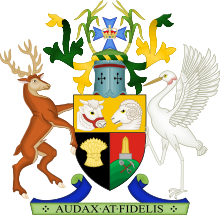Constitution of Queensland
| Constitution of Queensland | |
|---|---|
 | |
| Created | 28 December 1867 |
| System | Parliamentary democracy under a constitutional monarchy |
| Government structure | |
| Branches |
|
| Chambers | Legislative Assembly of Queensland |
| Executive | |
| Judiciary | Supreme Court of Queensland and other lower courts |
| Federalism | State within Australia |
| Entrenchments | 6 (all provisions within the Constitution Act 1867 (Qld)) |
| Citation |
|
| Supersedes |
|
The Constitution of Queensland sets out and regulates the powers of the major state institutions of the Australian state of Queensland. It is a written constitution, with most provisions contained within the Constitution of Queensland 2001 (Qld), which consolidated many previous constitutional laws. However, it does not contain all the constitutional principles of the state, with the Constitution Act 1867 (Qld), Australia Act 1986 (Cth), Australian Constitution, the governor's commission, the common law and constitutional conventions also relevant constitutional documents.[1]
The Constitution establishes Queensland as a constitutional monarchy operating under the Westminster system, with a parliament composed of the Legislative Assembly and the King exercising legislative powers, an executive made up of ministers and the premier appointed to act on behalf of the governor, and a judiciary made up of the Supreme Court and other lower courts.
Following the Federation of Australia, the colony of Queensland became a state within the new Commonwealth of Australia and ceded certain powers to the Commonwealth Government. However, except where valid Commonwealth laws conflict with the laws of Queensland, the Parliament of Queensland retains plenary legislative power[2]
Function
The Constitution establishes the government of Queensland and defines the structure, powers and function of the three branches of government:
- Legislature: the unicameral Parliament of Queensland, comprising the Legislative Assembly and the Monarch (represented by the Governor);
- Executive: the Executive Council of Queensland, which formalises decisions of the Cabinet of Queensland, which is composed of the Premier and other ministers of state appointed by the Governor on the advice of Parliament;
- Judiciary: the Supreme Court and other state courts, whose judges are appointed by the Governor on advice of Parliament.
The constitution also defines the role of the governor. Under the constitution, governmental authority is nominally vested in the Governor of Queensland (currently Jeannette Young) on behalf of the Crown and who is appointed by the Monarch (currently Charles III) on the advice of the Premier of Queensland. The governor's role is mostly ceremonial, however they serve constitutional roles such as, presiding over meetings of the Executive Council, summoning, proroguing and dissolving Parliament on the advice of the Premier, giving Royal Assent to Bills passed by the Parliament, appointing all ministers of state, appointing and removing officials on the advice of the Executive Council, issuing writs for Queensland State Elections and for the election of Queensland representatives in the Australian Senate, on the advice of the Executive Council and granting pardons or commutations.[3][4]
History
The current constitution is the Constitution of Queensland 2001.[5] It is the state's second constitution, consolidating various constitutional provisions dating back to the 19th century, and in particular the state's first constitution, the Constitution Act 1867.
Entrenchment and amendments
The constitution contains entrenched provisions which can only be amended by way of referendum. It also contains provisions which may be amended by legislation.[5]
Bill of rights
Queensland has a statutory human rights charter, the Human Rights Act 2019. This provides protections for 23 human rights, including freedom of expression, religion and privacy, and a right to education and health.[6]
Complaints of violations of human rights can be taken to the Queensland Human Rights Commission.
The Act does not stop parliament from passing legislation that is incompatible with human rights but they must consider human rights when drafting laws, and prepare a Statement of compatibility.[6] The Act can be overridden by declaration for certwin laws, as was done twice in 2023 to make breach of bail an offence for children[7] and to allow children to be detained indefinitely in adult police watch houses in response to community concern about youth crime.[8]
See also
References
General references
- Carney, Gerard (2006). The Constitutional Systems of the Australian States and Territories. Cambridge: Cambridge University Press. doi:10.1017/cbo9780511607288. ISBN 978-0-521-86305-6. Archived from the original on 8 December 2023. Retrieved 8 December 2023.
- White, Michael W. D.; Rahemtula, Aladin, eds. (2010). Queensland's constitution: past, present and future. Brisbane: Supreme Court of Queensland Library. ISBN 978-0-9803220-8-8.
- Winterton, George, ed. (2006). State constitutional landmarks. Annandale, NSW: Federation Press. ISBN 978-1-86287-607-1.
Specific references
- ^ "The Queensland Constitution". Queensland Parliament. Archived from the original on 28 October 2023. Retrieved 8 December 2023.
- ^ "Legislation". Queensland Law Handbook Online. 4 May 2016. Archived from the original on 2 February 2022. Retrieved 2 February 2022.
- ^ "What Type of Government Does Australia Have?". WorldAtlas. 10 April 2019. Archived from the original on 14 February 2022. Retrieved 14 February 2022.
- ^ "Role of the Governor". Government House Queensland. Archived from the original on 4 March 2022. Retrieved 2 February 2022.
- ^ a b "The Queensland Constitution - Queensland Parliament". www.parliament.qld.gov.au. Archived from the original on 3 April 2020. Retrieved 24 May 2020.
- ^ a b Caldwell, Felicity (27 February 2019). "Queenslanders' human rights to be enshrined in law". Brisbane Times. Archived from the original on 2 February 2022. Retrieved 2 February 2022.
- ^ Gillespie, Eden (16 March 2023). "Queensland passes controversial youth crime laws after heated human rights debate". The Guardian. ISSN 0261-3077. Archived from the original on 29 August 2023. Retrieved 15 December 2023.
- ^ Messenger, Andrew; Gillespie, Eden (23 August 2023). "'Absolute dog act': Queensland Labor criticised for shock move to override state's Human Rights Act". The Guardian. ISSN 0261-3077. Archived from the original on 15 December 2023. Retrieved 15 December 2023.
